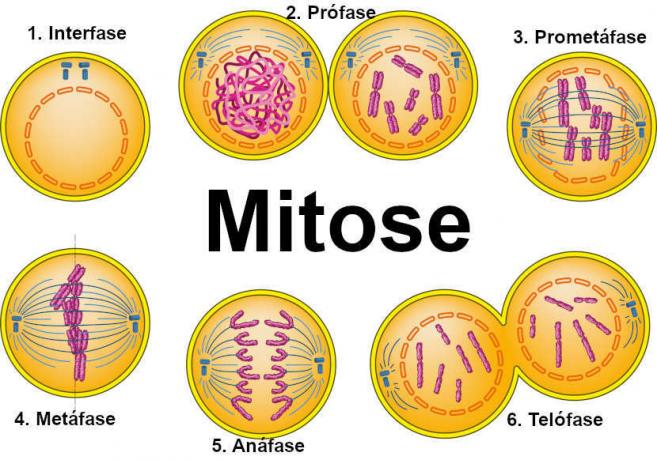cell cycle is the lifetime of a cell and corresponds to the period from its formation by the division of the parental cell until its division giving rise to two daughter cells. Interphase and mitosis are phases of the cell cycle. During interphase, the cell has a great metabolic activity and increases in size. In mitosis, the cell divides into two daughter cells.
Read more: Cellular respiration - one of the processes performed by the cell in order to generate energy for its activities
Cell cycle summary
The cell cycle corresponds to the period between the appearance of the cell after cell division and the moment of its own division.
The cell cycle has two phases: the interphase and the mitotic phase.
Interphase is characterized by cell growth and duplication of chromosomes.
The mitotic phase is the moment when the cell divides into two daughter cells.
Mitosis can be didactically divided into five stages: prophase, prometaphase, metaphase, anaphase and telophase.
O cytoplasm The cell divides in a process called cytokinesis.
Video lesson on cell cycle
cell cycle phases
The cell cycle has two stages: interphase and mitosis. Let's get to know each of these phases in more detail below:
interface
the interface comprises the period between two cell divisions. It corresponds to about 90% of the cell cycle and can be divided into G1, Mon2. During all three of these steps, the cell is increasing in size and production of proteins it's from cytoplasmic organelles. Chromosomes are duplicated during what is called the S phase.
In a simplified way, we can say that, in phase G1, the cell starts to increase in size, enters the S phase, in which its chromosomes are duplicated and their growth is still observed, and continues to grow during the G phase.2, in which it completes preparations for cell division. Some cells in G1 delay the progress of the cell cycle by entering a resting period called G0 (G zero). Nerve cells and skeletal muscle cells, for example, remain in G0 while the organism is alive.
Mitosis

THE mitosis it starts after the interphase, being called the M phase of the cell cycle. It can be divided didactically into five stages: prophase, prometaphase, metaphase, anaphase and telophase. During the last stages of mitosis, a process called cytokinesis, which promotes the cytoplasmic separation of cells. Let's learn more about the steps of mitosis below:
Prophase: it is the first stage of mitosis. During this step, we observe the condensation of chromosomes, the nucleolus disappears, and the formation of the so-called mitotic spindle begins, formed by the centrosome (centre of organization of microtubules where a pair of centrioles is located) and by the microtubules (protein structures), which depart their. During prophase, the spindle grows, causing the centrosomes to move apart.
Prometaphase: at this stage the wrap nuclear it fragments and the chromosomes continue their condensation. Some microtubules attach to kinetochores (a protein structure that connects each sister chromatid to the mitotic spindle) and others interact with other microtubules from the opposite pole. The microtubules that have attached to the kinetochores are called the kinetochore microtubules.
Metaphase: chromosomes assemble in the equatorial region of the cell and reach their greatest degree of condensation. Centrosomes are arranged at opposite poles of the cell.
Anaphase: it is the shortest stage of mitosis. In it, the separation of the sister chromatids takes place, and the released daughter chromosomes move towards the poles of the cell. At the end of this step, we can see that the cell has complete collections of chromosomes at each end.
-
Telophase: it is the last stage of mitosis, and the cell is seen to begin to re-establish its normal structure. In telophase, it is verified that the nuclear envelopes appear again, as well as the nucleolus. Chromosomes start to decondense.
Cytokinesis: it is characterized by the division of the cell's cytoplasm. It usually occurs at the end of telophase. At the end of cytokinesis, it is possible to observe the appearance of two daughter cells
Read too: Differences between mitosis and meiosis
Cell cycle and cancer
Cells have a cell cycle control system, which ensures that the time and rate of cell division occur properly. While some human cells divide frequently, such as epithelial cells, other cells do not divide in a mature human, such as muscle cells.
This is essential for the proper functioning of the body. At cancer cells, however, do not properly obey the signals that regulate the cell cycle. They have uncontrolled cell division, which triggers the formation of tumors.



